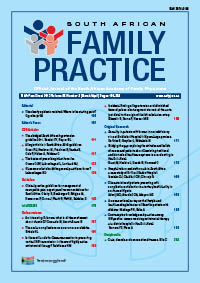Clinical practice guidelines for management of neuropathic pain: expert panel recommendations for South Africa
Keywords:
neuropathic pain, management, clinical practice guidelines
Abstract
Neuropathic pain (NeuP) is challenging to diagnose and manage, despite ongoing improved understanding of the underlying mechanisms. Many patients do not respond satisfactorily to existing treatments. There are no published guidelines for diagnosis or management of NeuP in South Africa. A multidisciplinary expert panel critically reviewed available evidence to provide consensus recommendations for diagnosis and management of NeuP in South Africa. Following accurate diagnosis of NeuP, pregabalin, gabapentin, low-dose tricyclic antidepressants (e.g. amitriptyline) and serotonin norepinephrine reuptake inhibitors (duloxetine and venlafaxine) are all recommended as first-line options for the treatment of peripheral NeuP. If the response is insufficient after 2 - 4 weeks, the recommended next step is to switch to a different class, or combine different classes of agent. Opioids should be reserved for use later in the treatment pathway, if switching drugs and combination therapy fails. For central NeuP, pregabalin or amitriptyline are recommended as first-line agents. Companion treatments (cognitive behavioural therapy and physical therapy) should be administered as part of a multidisciplinary approach. Dorsal root entry zone rhizotomy (DREZ) is not recommended to treat NeuP. Given the large population of HIV/AIDS patients in South Africa, and the paucity of positive efficacy data for its management, research in the form of randomised controlled trials in painful HIV-associated sensory neuropathy (HIV-SN) must be prioritised in this country.
Section
Guidelines
By submitting manuscripts to SAFP, authors of original articles are assigning copyright to the South African Academy of Family Physicians. Copyright of review articles are assigned to the Publisher, Medpharm Publications (Pty) Ltd, unless otherwise specified. Authors may use their own work after publication without written permission, provided they acknowledge the original source. Individuals and academic institutions may freely copy and distribute articles published in SAFP for educational and research purposes without obtaining permission.

